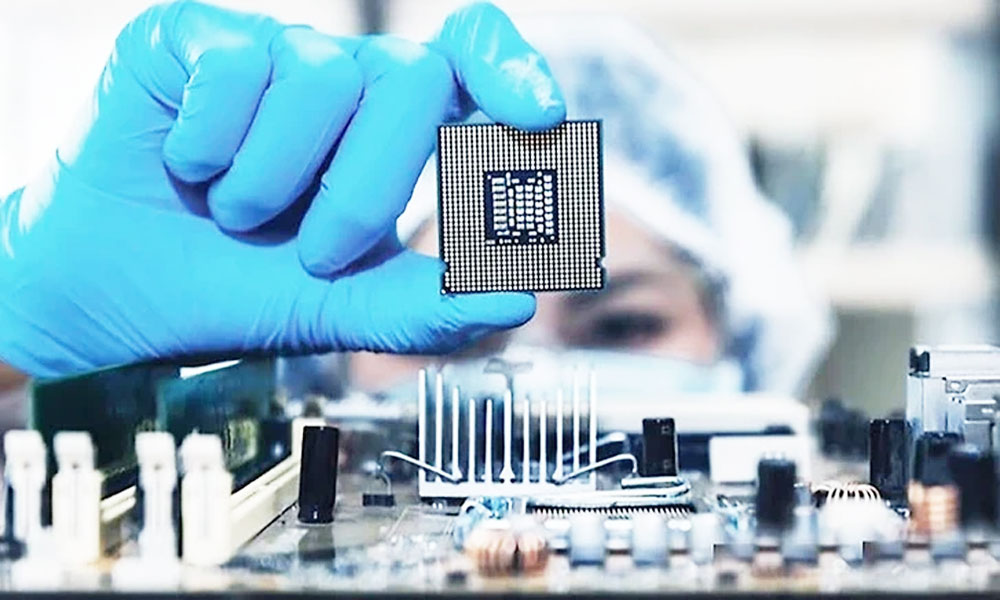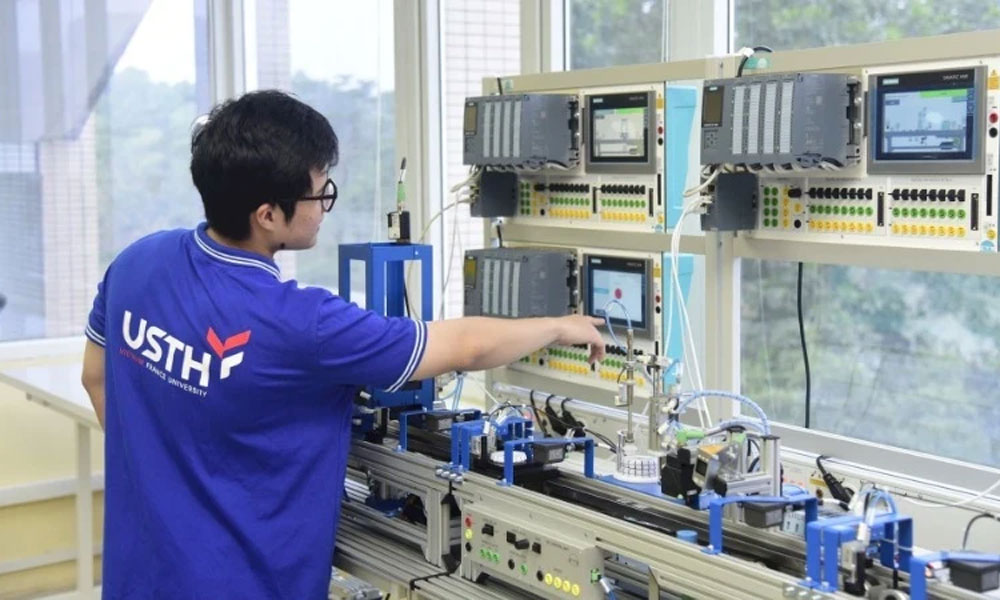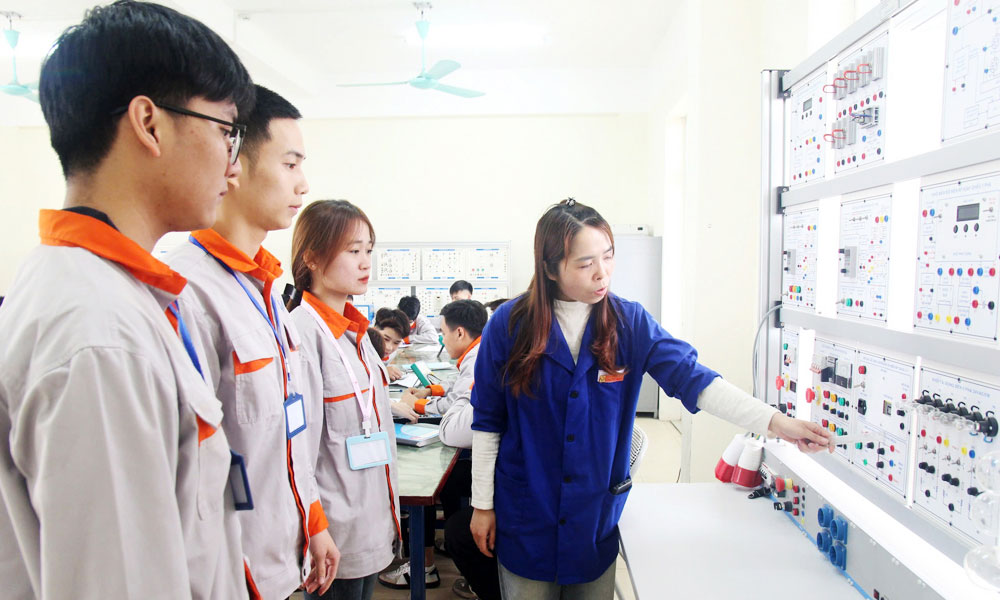Opportunities to meet human resource demands in semiconductor industry
Amidst a wave of semiconductor industry investments flowing into Vietnam, the government has set a goal to train 50,000 microchip engineers by 2030. Numerous universities are launching new majors, and various incentive policies are being implemented to attract students. This is considered a golden opportunity for both learners and educational institutions.
In Vietnam, the semiconductor industry is still relatively new, mainly focusing on chip design, testing, and packaging, with no large-scale manufacturing plants yet.
 |
|
Wide-open opportunities, but the semiconductor field demands high ability and potential from students. |
Recently, Vietnam has continuously welcomed major investment projects from global tech giants such as Intel, Samsung, Amkor, and Hana Micron.
More than 50 international companies have joined the market, including Intel, Amkor, and Hana Micron (packaging and testing) and Marvell, Synopsys, and Cadence (chip design).
Domestic companies such as Viettel, FPT, and VNChip have also entered the field. Vietnam is putting great effort into developing the semiconductor industry, which is considered the “backbone” of the digital economy, with a strong focus on building a skilled workforce.
A wave of semiconductor training programmes
Seizing the golden opportunity presented by investment, and recognising human resources as the key factor, the government approved the “Semiconductor industry human resource development programme to 2030” in September 2024.
 |
|
Students of the University of Science and Technology of Hanoi practice in the laboratory. |
The programme aims to train at least 50,000 university-level personnel for the semiconductor field by 2030.
Of this, about 15,000 will serve chip design, while 35,000 will cover manufacturing, packaging, and product testing. Additionally, 5,000 AI specialists will be trained to support and elevate the semiconductor sector, along with 1,300 university and research institute lecturers receiving advanced training to form an elite teaching force ready to propel Vietnam forward in the global tech race.
According to the Ministry of Education and Training, about 35 higher education institutions have joined or are joining the training effort. This number is expected to grow significantly in the next 2-3 years as vocational colleges and corporate training partnerships come into play.
Three universities under the Vietnam National University, Ho Chi Minh City (University of Technology, University of Information Technology, and University of Science) have officially launched semiconductor technology programmes, aiming to train an additional 1,000 engineers by 2027 and increase the total number of students in related fields to about 6,000.
Hanoi University of Science and Technology has also developed two direct majors and seven related ones in microchip technology, enrolling over 3,300 students. Vietnam National University, Hanoi trains about 1,500 students annually and plans to double that number soon.
Notably, from 2025, the University of Engineering and Technology (under Vietnam National University, Hanoi) will launch three out of four new semiconductor majors: Electronics-Telecommunications Technology (with a focus on microchip design), Materials Technology (Materials Technology and Microelectronics programme), and Data Science (Data Science and Engineering programme).
The University of Danang offers a chip design major from 2024 through units such as the University of Technology, University of Technical Education, and Vietnam-Korea University of Information and Communication Technology.
This wave is also spreading to private and other public universities. Institutions such as the University of Science and Technology of Hanoi (USTH), FPT University, Phenikaa University, Saigon International University, and Can Tho University are all launching new majors in 2024.
The University of Science (Vietnam National University, Hanoi) is partnering with National Yang Ming Chiao Tung University (China’s Taiwan) to open a bachelor’s programme in semiconductor technology.
The Vietnam-Japan University (Vietnam National University, Hanoi) will recruit 100 new semiconductor engineering students starting in 2025.
Alongside these opportunities come significant challenges, especially in ensuring training quality. Experts warn that the semiconductor industry demands extremely high standards, with technology updating every 6 to 12 months, while university curriculum reform often lags.
This leads to graduates lacking practical skills and struggling to meet global market demands.
Lecturer quality and facilities are also major bottlenecks for institutions. Prof. Dr. Phan Manh Huong (University of South Florida, the US) commented, “To train a large semiconductor workforce, we first need knowledgeable lecturers in this field – something we are currently severely lacking.”
Prof. Dr. Chu Duc Trinh, Rector of the University of Engineering and Technology under the Vietnam National University, Hanoi, added that the concern is not overproducing graduates, but producing too few.
The core issue is improving training standards, so graduates are competitive globally. If that’s achieved, even a sharp rise in microchip students will still meet strong demand from domestic and international firms.
High expectations for students
Nguyen Phuc Vinh, Technical Director at Synopsys Vietnam, said demand for chip design engineers is high and current supply is inadequate.
In fact, third-year students are already being sought after by companies, especially in physical design and chip testing. However, while opportunities abound, the semiconductor field places heavy demands on students’ abilities and qualities.
Prof. Dr. Chu Duc Trinh emphasised: not every university qualifies to offer training, and not all students meet the stringent requirements of this sector.
Students need a strong foundation in Math, Physics, Chemistry, and Computer Science, logical thinking, a passion for technology, good foreign language skills (especially English), and soft skills (teamwork, presentation, project management). They must also be curious, creative, and able to handle high pressure.
Currently, only about 30% of Vietnamese university students are in STEM (Science, Technology, Engineering, and Math). For many years, high school students have mostly chosen social science fields over natural sciences, making it hard for engineering and technology majors to recruit.
Ironically, while there is a high demand for talent, universities struggle to enroll enough students. Nonetheless, with promising high salaries and attractive work environments in the chip sector, this trend is expected to change as more tech-passionate youth set their sights on microchip design.
That said, students must also anticipate the unique difficulties of this field. Learning chip design is tough, the curriculum is practice-heavy, and Vietnam still lacks many semiconductor companies and projects for internships.
Additionally, creating sample chip projects is expensive. As a result, students must proactively seek hands-on experience through research, international chip design competitions, or internships with foreign companies; and take full advantage of support from schools and businesses (scholarships, equipment, etc.).
Tuition fees for semiconductor training programmes in Vietnam vary widely, from about 16 to 78 million VND (618 – 3,000 USD) per year depending on the school.
Therefore, additional support from the government and companies is seen as a crucial “leverage” to attract potential learners.
The 2025-2026 university admissions season is approaching, a pivotal time to shape the future and careers of thousands of young people.
As Vietnam ramps up its investment in the semiconductor industry, this is not just a promising career opportunity, but a “golden ticket” for those truly passionate about technology and ambitious to go far.
However, this door will only open for those who are courageous, persistent, and ready to embark on a challenging yet rewarding journey to become engineers in one of the 21st century’s most cutting-edge industries.
 Bắc giang
Bắc giang













Reader's comments (0)